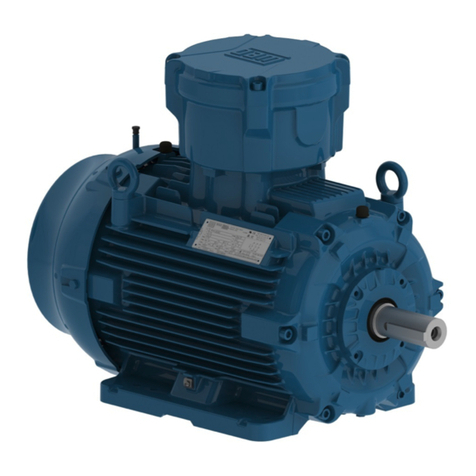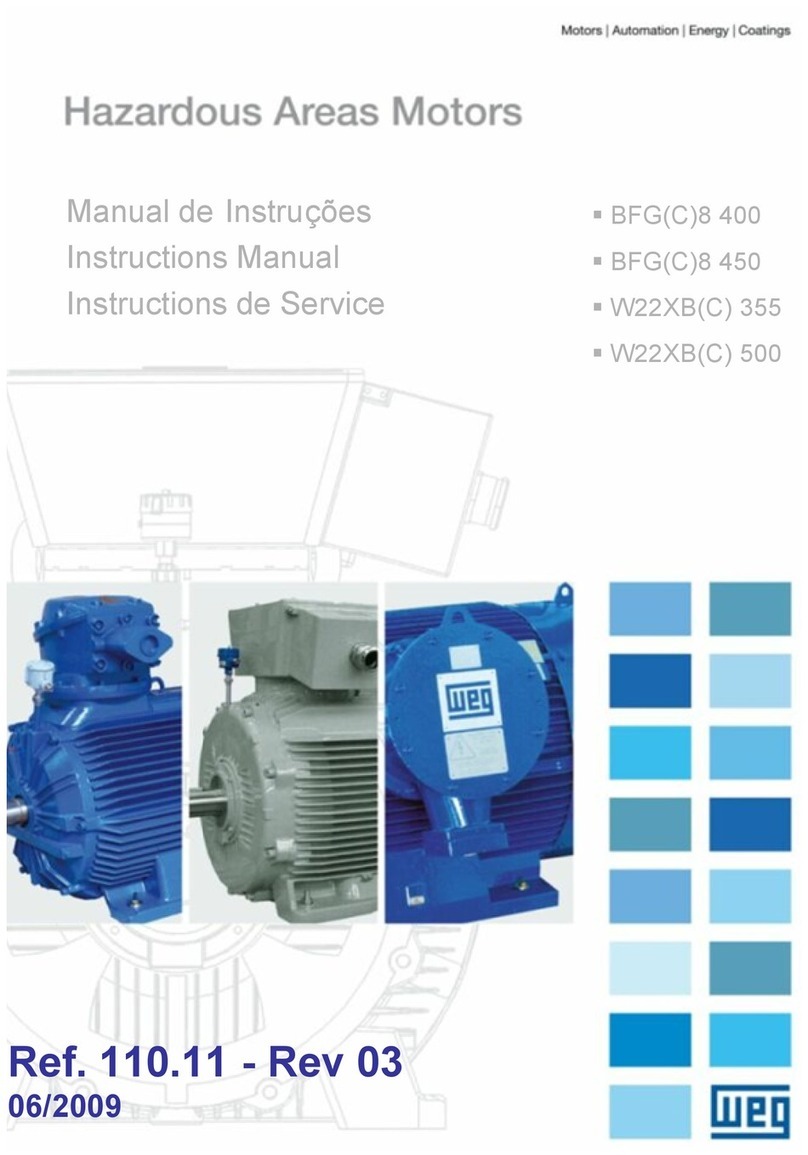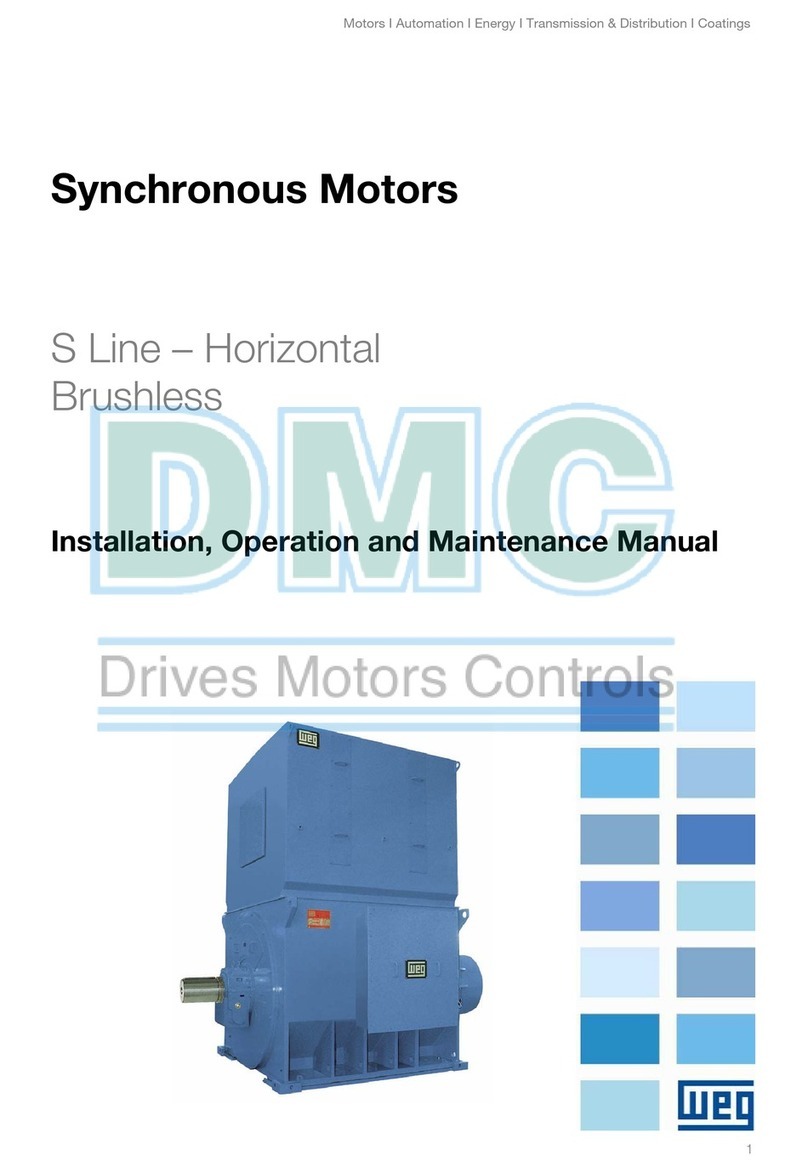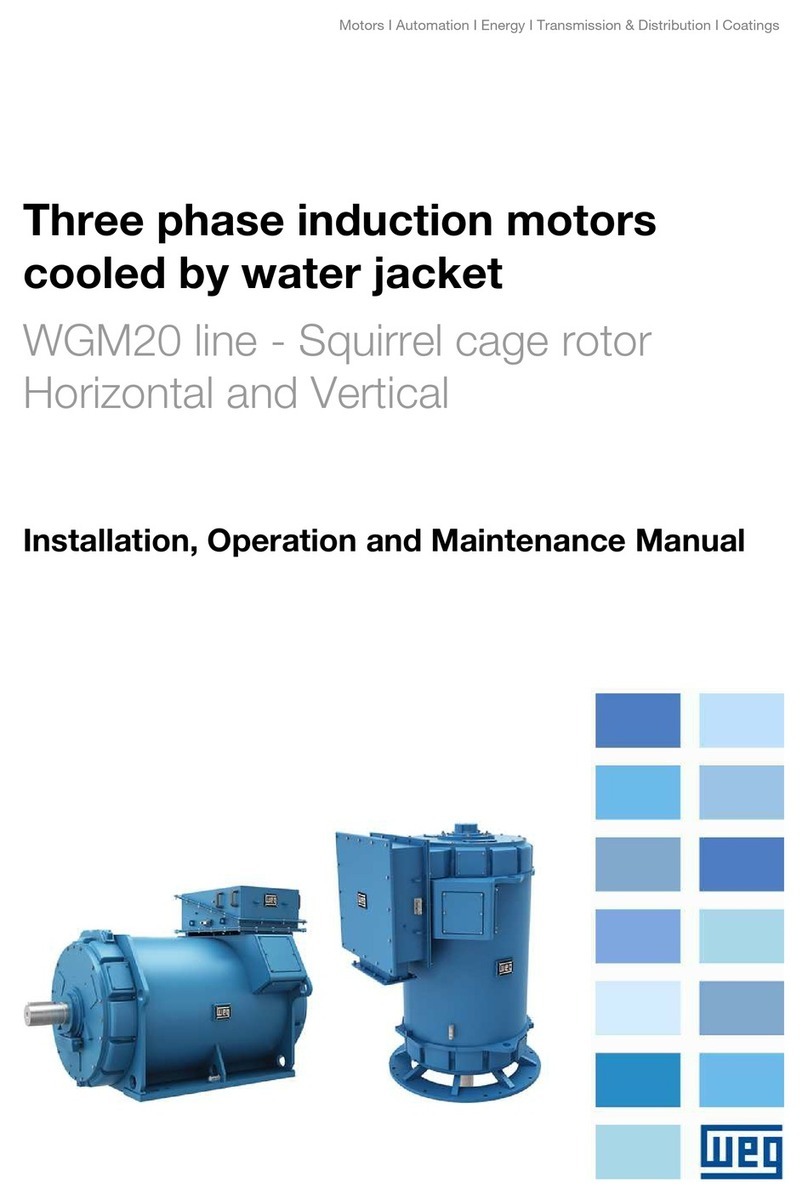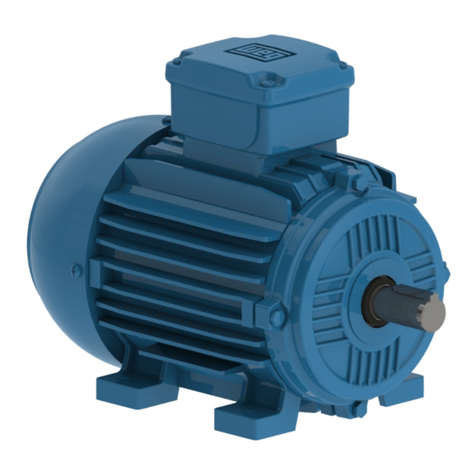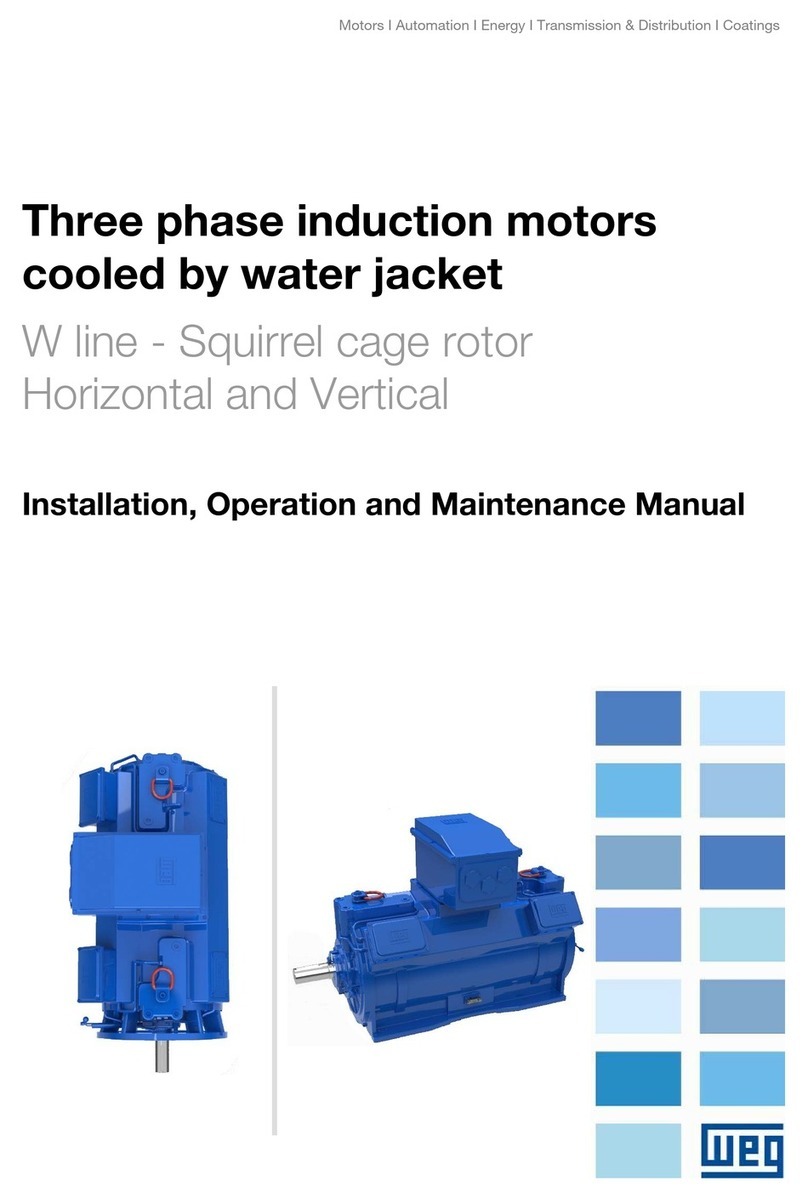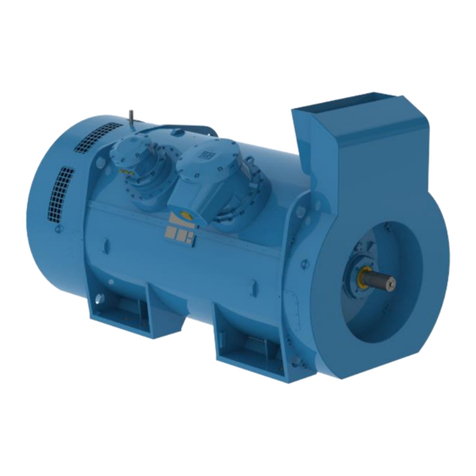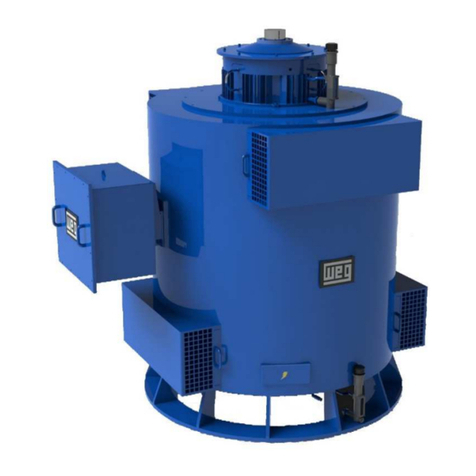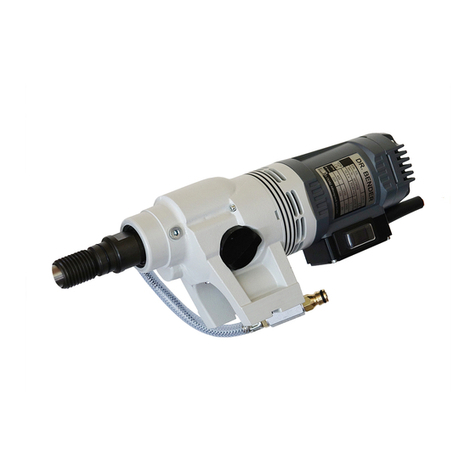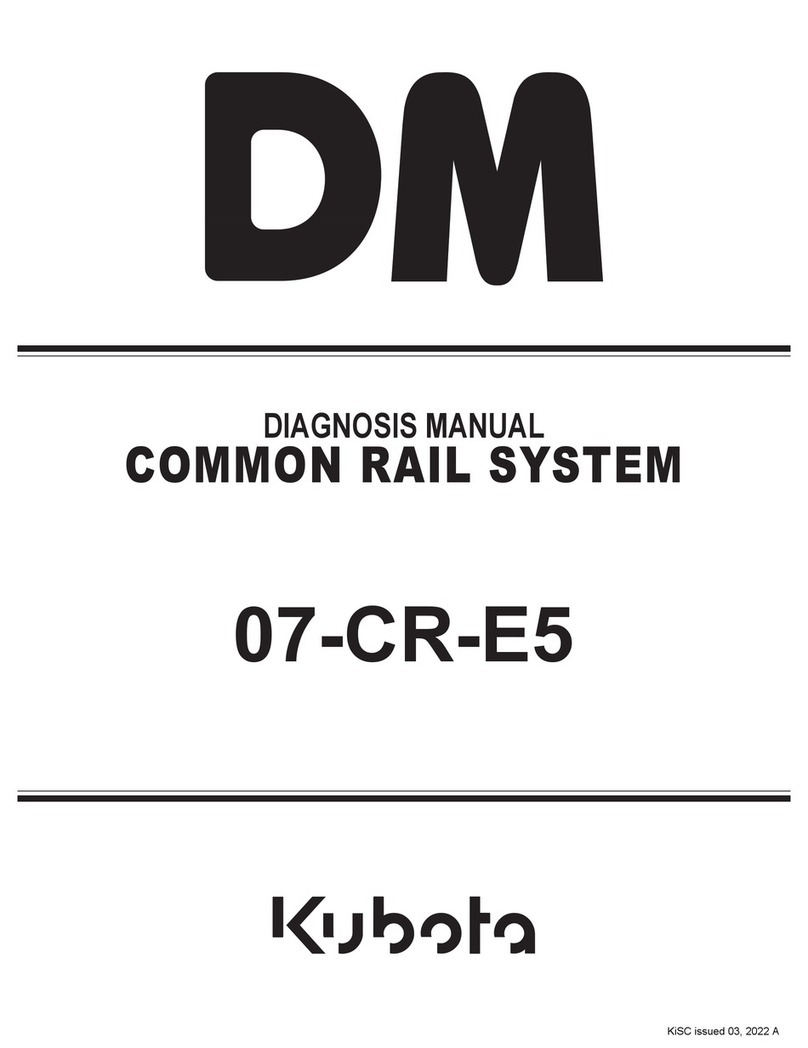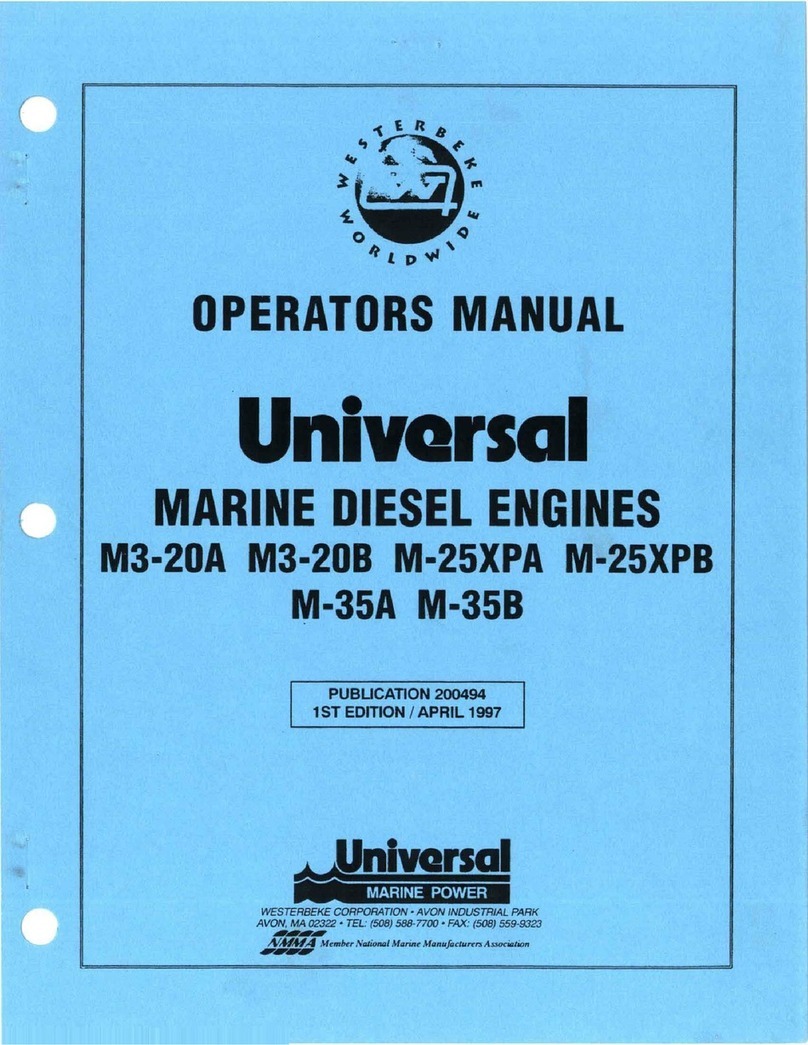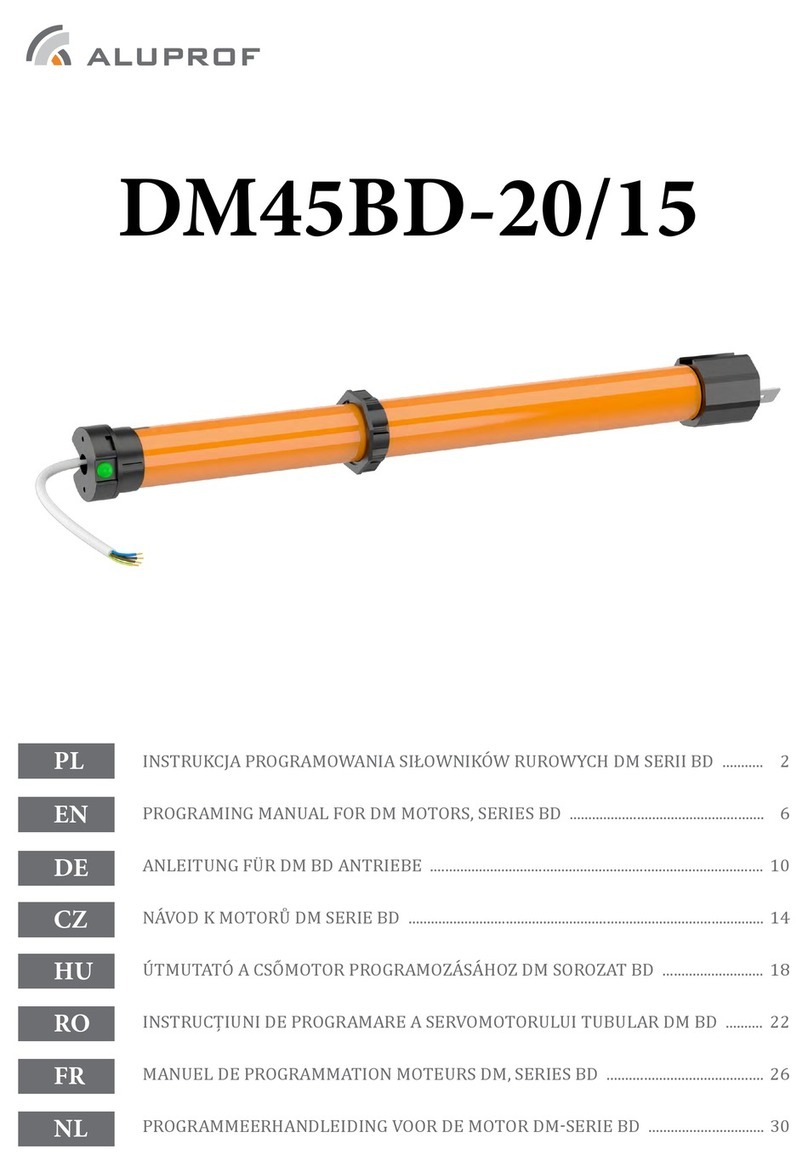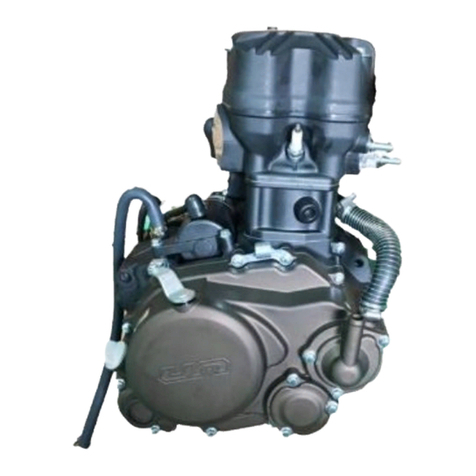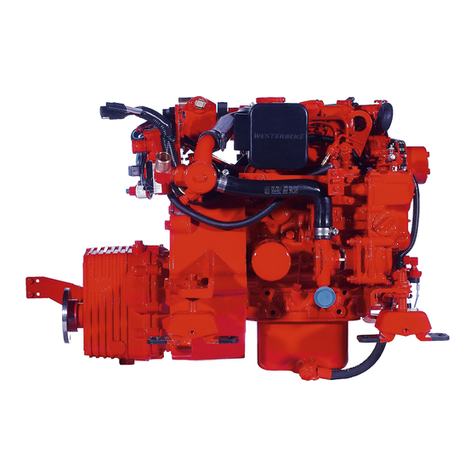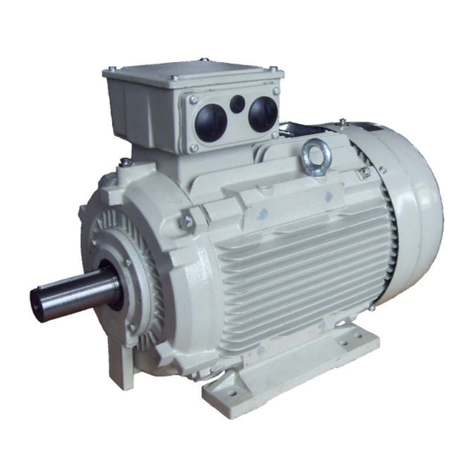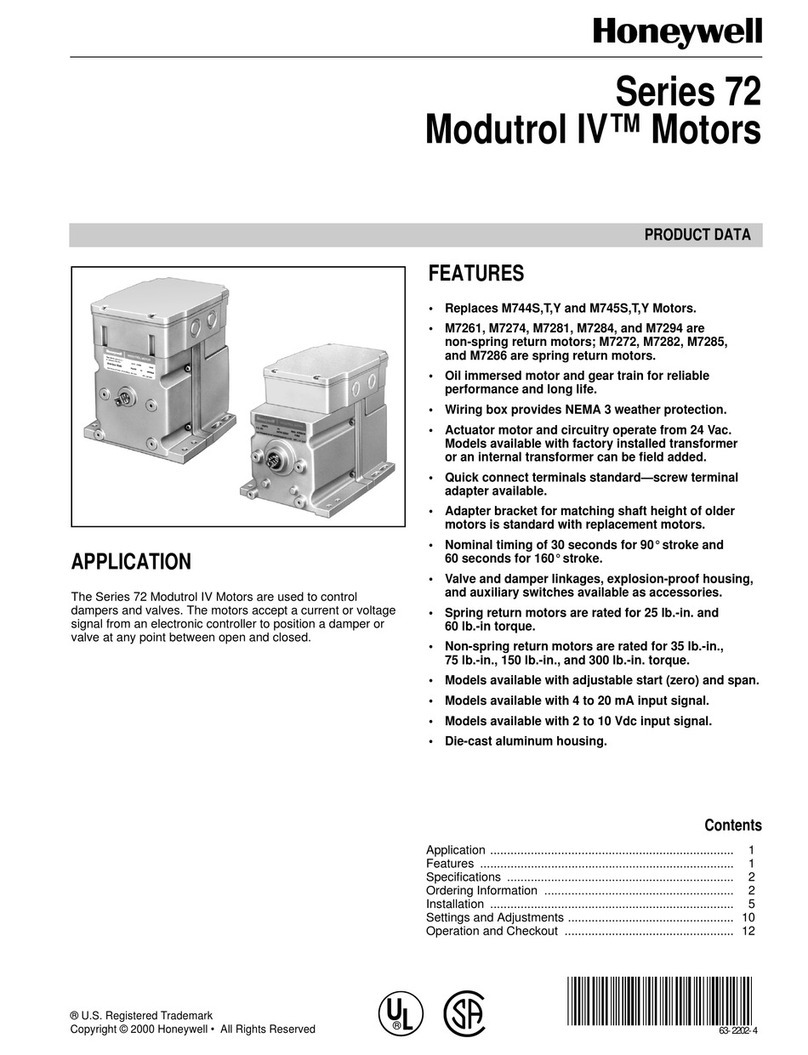WEG GPW Series User manual

www.weg.net
Installation, operation and maintenance manual |
5
Dear Customer,
Thank you for purchasing the WEG alternator. It is a product developed with quality and efficiency
levels that ensure optimal performance.
Electricity plays a role of major importance for the comfort and well-being of humanity. Since the
alternator is responsible for generating this energy, it must be identified and treated as a machine
whose characteristics require certain care, including storage, installation, operation and maintenance.
All efforts were made to ensure the information contained herein is accurate regarding the
configurations and use of the alternator.
Thus, we recommend reading this manual carefully before installing, operating and servicing the
alternator in order to ensure a safe and continuous operation of the alternator and guarantee the
personnel’s and installations’ safety. If you need any further information, please, contact WEG.
Keep this manual always near the alternator, so it can be referred to whenever necessary.
ATTENTION
1. It is imperative to follow the procedures contained in this manual for the warranty to be valid;
2. The procedures for installation, operation and maintenance of the alternator must be carried out by
qualified people.
NOTE
1. Reproduction of the information contained in this manual, in whole or in part, is permitted provided that
the source is mentioned;
2. If this manual is lost, a copy in electronic format may be obtained at www.weg.net or you may request
WEG a printed copy.
WEG EQUIPAMENTOS ELÉTRICOS S.A.

www.weg.net
Installation, operation and maintenance manual |
7
INDEX
1INTRODUCTION...............................................................................................11
1.1SAFETY WARNINGS IN THE MANUAL .......................................................................................11
1.2TERMINOLOGY...........................................................................................................................11
2GENERAL INSTRUCTIONS ...............................................................................12
2.1QUALIFIED PEOPLE....................................................................................................................12
2.2SAFETY INSTRUCTIONS ............................................................................................................12
2.3STANDARDS...............................................................................................................................12
2.4ENVIRONMENT...........................................................................................................................12
2.4.1Aggressive and/or sea environments ............................................................................12
2.5OPERATING CONDITIONS .........................................................................................................12
3RECEIVING, STORAGE AND HANDLING...........................................................13
3.1RECEIVING .................................................................................................................................13
3.2STORAGE ...................................................................................................................................13
3.2.1Storage in sheltered environment .................................................................................13
3.2.2Storage in unprotected environment.............................................................................13
3.2.3Extended storage .........................................................................................................13
3.2.3.1Storage location........................................................................................................13
3.2.3.1.1Storage in sheltered environment ...........................................................14
3.2.3.1.2Unprotected storage environment ..........................................................14
3.2.3.2Parts .........................................................................................................................14
3.2.3.3Space heaters...........................................................................................................14
3.2.3.4Insulation resistance..................................................................................................14
3.2.3.5Exposed machined surfaces .....................................................................................14
3.2.3.6Bearings ...................................................................................................................14
3.2.3.7Terminal box .............................................................................................................15
3.2.3.8Inspections and records during storage.....................................................................15
3.2.3.9Preparation for commissioning ..................................................................................15
3.2.3.9.1Cleaning ................................................................................................15
3.2.3.9.2Bearing lubrication .................................................................................15
3.2.3.9.3Checking the insulation resistance..........................................................15
3.2.3.10Cooling system .........................................................................................................15
3.2.3.11Others.......................................................................................................................15
3.2.3.12Maintenance Plan during storage ..............................................................................16
3.3HANDLING..................................................................................................................................17
4INSTALLATION ................................................................................................18
4.1INSTALLATION LOCATION .........................................................................................................18
4.2DIRECTION OF ROTATION .........................................................................................................18
4.3DEGREE OF PROTECTION.........................................................................................................18
4.4COOLING....................................................................................................................................18
4.4.1Characteristics of the cooling water..............................................................................19
4.4.2Heat exchangers for applications with sea water ..........................................................19
4.4.3Cooling water temperature ...........................................................................................19
4.4.4Protective devices ........................................................................................................19
4.5INSULATION RESISTANCE.........................................................................................................20
4.5.1Safety instructions ........................................................................................................20
4.5.2General considerations .................................................................................................20
4.5.3Measuring the stator winding........................................................................................20
4.5.4Measurement on the winding of the rotor, exciter and accessories...............................20
4.5.5Minimum insulation resistance ......................................................................................21
4.5.6Polarization index..........................................................................................................21
4.5.7Conversion of the measured values ..............................................................................21
4.6PROTECTIONS ...........................................................................................................................21
4.6.1Thermal protections......................................................................................................21
4.6.1.1Temperature limits for the windings ...........................................................................22
4.6.1.2Thermal protections for the bearings .........................................................................22
4.6.1.3Alarm and shutdown temperatures............................................................................22
4.6.2Space heater ................................................................................................................22

www.weg.net
l Installation, operation and maintenance manual
8
4.6.3Diode protection .......................................................................................................... 23
4.6.4Protections on the voltage regulator............................................................................. 23
4.6.4.1Protection against underfrequency ........................................................................... 23
4.7VOLTAGE REGULATOR ............................................................................................................. 23
4.8AUXILIARY EXCITER................................................................................................................... 23
4.9ELECTRICAL ASPECTS ............................................................................................................. 23
4.9.1Electrical connections .................................................................................................. 23
4.9.1.1Main connection....................................................................................................... 23
4.9.1.2Grounding ................................................................................................................ 23
4.9.1.3Electronic voltage regulator....................................................................................... 23
4.9.1.4Terminal identification ............................................................................................... 24
4.9.1.5Electrical connection of the voltage regulator ............................................................ 24
4.9.2Accessories ................................................................................................................. 24
4.9.2.1Excitation and sensing.............................................................................................. 24
4.9.2.2Parallel operation...................................................................................................... 24
4.9.2.3Differential protection................................................................................................ 24
4.10MECHANICAL ASPECTS ........................................................................................................... 24
4.10.1Bases and foundations ................................................................................................ 24
4.10.2Alignment and leveling ................................................................................................. 24
4.10.3Coupling ...................................................................................................................... 25
5START-UP .......................................................................................................26
5.1PRELIMINARY INSPECTION ...................................................................................................... 26
5.2INITIAL OPERATION................................................................................................................... 26
5.2.1Temperatures .............................................................................................................. 26
5.2.2Bearings ...................................................................................................................... 26
5.2.3Radiator ....................................................................................................................... 27
5.3SHUTDOWN............................................................................................................................... 27
5.4PARALLEL ALTERNATORS........................................................................................................ 27
5.4.1Parallel to each other and/or to the line........................................................................ 27
6MAINTENANCE................................................................................................28
6.1EMERGENCY GENERATOR GROUPS ....................................................................................... 28
6.2CLEANING ................................................................................................................................. 28
6.3NOISE......................................................................................................................................... 28
6.4VIBRATION................................................................................................................................. 28
6.5BEARINGS ................................................................................................................................. 28
6.5.1Lubrication................................................................................................................... 28
6.5.1.1Type and amount of grease...................................................................................... 28
6.5.1.2Instructions for lubrication......................................................................................... 28
6.5.1.3Relubrication of bearing with the alternator operating................................................ 29
6.5.2Bearing ........................................................................................................................ 29
6.5.2.1Bearing replacement ................................................................................................ 29
6.6MAINTENANCE OF THE EXCITER.............................................................................................. 29
6.6.1Exciter.......................................................................................................................... 29
6.6.2Diode test .................................................................................................................... 29
6.6.3Diode Replacement ..................................................................................................... 30
6.6.4Varistor test.................................................................................................................. 30
6.6.5Varistor replacement.................................................................................................... 30
6.7AIR FLOW................................................................................................................................... 30
6.8MAINTENANCE OF THE COOLING SYSTEM............................................................................. 30
6.8.1Maintenance of the radiators........................................................................................ 30
6.9ALTERNATOR OUT OF OPERATION.......................................................................................... 31
6.10SHAFT GROUNDING DEVICE .................................................................................................... 31
6.10.1Grounding with internal brush ...................................................................................... 31
6.10.2Grounding with external brush ..................................................................................... 31
6.11COMPLETE CHECKUP .............................................................................................................. 32
7DISASSEMBLY AND ASSEMBLY OF THE ALTERNATOR...................................33
7.1DISASSEMBLY........................................................................................................................... 33
7.2ASSEMBLY ................................................................................................................................ 33
7.3SPARE PARTS ........................................................................................................................... 33

www.weg.net
Installation, operation and maintenance manual |
9
7.4TIGHTENING TORQUES .............................................................................................................33
7.5GENERAL RECOMMENDATIONS ...............................................................................................33
8MAINTENANCE PLAN ......................................................................................34
9TROUBLESHOOTING .......................................................................................35
9.1ELECTRICAL ANOMALIES ..........................................................................................................35
9.2MECHANICAL ANOMALIES ........................................................................................................36
9.3ENVIRONMENTAL INFORMATION..............................................................................................36
9.3.1Package .......................................................................................................................36
9.3.2Product ........................................................................................................................36
10WARRANTY .....................................................................................................37

www.weg.net
Installation, operation and maintenance manual |
11
1INTRODUCTION
This manual is intended to provide the necessary information on synchronous alternators GPW, GPA, GPF, GSW, GSA, GSF
models. Alternators with special features can be supplied with specific documents (drawings, wiring diagrams, characteristic
curves, etc.). These documents must be carefully studied together with this manual before installing, operating or servicing
the alternator.
Contact WEG if it is necessary further explanations. All procedures and standards contained in this manual must be
observed in order to ensure the correct operation of the alternator and the safety of the professionals involved in its
operation. Observing these procedures is also important to ensure the warranty of the alternator. Thus, we recommend
reading this manual thoroughly before installing and operating the alternator. If applicable further information if necessary,
contact WEG.
ATTENTION
In case of replacement of the components mentioned in this manual, the manufacturing date must be
checked against the manual review date.
1.1 SAFETY WARNINGS IN THE MANUAL
In this manual are used the following safety warnings:
DANGER
Failure to observe the procedures recommended in this warning may result in substantial property
damage, serious injury or death.
ATTENTION
Failure to observe the procedures recommended in this warning may result in property damage.
NOTE
The text with this warning is intended to provide important information for the correct understanding and
proper operation of the product.
1.2 TERMINOLOGY
G P W 450
ALTERNATOR SERIES
G- Synchronous Machines for generator groups
EXCITATION CHARACTERISTICS
P- Brushless alternator with auxiliary exciter (PMG)
S- Brushless alternator without auxiliary exciter
COOLING SYSTEM
A- Open self-ventilated
F- Closed with air-air heat exchanger
W- Closed with air-water heat exchanger
FRAME - IEC
450 to 630

www.weg.net
l Installation, operation and maintenance manual
12
2GENERAL INSTRUCTIONS
Professionals who work with electrical installations, either in their assembly, operation or maintenance, must be continuously
updated and informed about safety rules and recommendations concerning the service and are advised to observe them
strictly. Before beginning any job, the person in charge must make sure that all the safety measures were properly taken and
warn the operators of the dangers inherent to the task performed. Alternators of this kind, if improperly used or poorly
serviced, or when service by unqualified people, may cause serious personal injury and/or material damage. Therefore, it is
recommended that these services be always performed by qualified people.
2.1 QUALIFIED PEOPLE
The term qualified person means those who, due to their
training, experience, education level, knowledge of
applicable standards, specifications, safety standards,
accident prevention and knowledge of the operating
conditions, have been authorized by the people in charge
to execute all necessary services, and who are able to
recognize and avoid any possible danger.
Those qualified people must also know first aid
procedures and be able to provide that if necessary.
It is assumed that the entire commissioning, maintenance
and repair work is made by qualified people only.
2.2 SAFETY INSTRUCTIONS
DANGER
During operation, this equipment has
energized or rotating parts exposed, which
may present high voltage or high
temperatures.
Thus, the operation with terminal boxes
open, unprotected couplings, or incorrect
operation, disregarding the operating
standards, may cause serious injury and
property damage.
Those responsible for the safety in the installation must
ensure that:
Only qualified people install and operate the equipment;
Those people have this manual at hand and other
documents supplied with the alternator, as well as
perform the work strictly observing the service
instructions, relevant standards and specific
documentation of the products.
Failure to comply with installation and safety standards
may void the product warranty.
Equipment for fire fighting and first aid signs must be
provided at the workplace in clearly visible and easily
accessible places.
Also, observe:
All technical data regarding applications permitted
(operating conditions, connections and installation
environment) contained in the catalog, order
documentation, operating instructions, manuals and
other documents;
The determinations and conditions specific to the
installation site;
The use of tools and equipment suitable for handling
and transport;
That the protective devices of the individual
components be removed shortly before installation.
The individual parts must be stored in an environment free
of vibrations, preventing falls and ensuring that they are
protected against aggressive agents and/or do not
endanger the safety of people.
2.3 STANDARDS
Alternators are specified, designed, manufactured and
tested according to the following standards:
Table 2.1: Applicable Standards
IEC NBR ISO
Specification 60034-1 5117
Dimensions 60072 5432
Tests 60034-4 5052
Degree of protection 60034-5 9884
Cooling 60034-6 5110
Mounting 60034-7 5031
Noise 60034-14 5117 8528
2.4 ENVIRONMENT
In accordance with IEC-60034.1, and ABNT 5117, the
ambient operating conditions for which the alternators
were designed are as follows:
1. Ambient temperature: – 15 ºC to + 40 ºC;
2. Altitude (m.a.s.l.): up to 1000 m;
3. Environments according to the degree of protection
of the alternator.
Special environment conditions are described on the
nameplate and specific data sheet of the alternator.
A
TTENTION
In order to use water-cooled alternators at
temperatures below 0 °C, antifreeze additives
must be used in the water.
2.4.1 Aggressive and/or sea environments
The standard industrial alternator should not be used in
aggressive environments, since this will be subject to
weather action that can cause corrosion of mechanical
parts and a decrease in insulation resistance of the coils
and as a result, the alternator burning. In these situations,
WEG is not liable for damage that may occur in the
alternator, not characterizing the product warranty as the
warranty certificate of WEG.
2.5 OPERATING CONDITIONS
For the warranty of the product to be valid, the alternator
must operate according to the rated data, follow
applicable standards and codes and the information
contained herein.

www.weg.net
Installation, operation and maintenance manual |
13
3RECEIVING, STORAGE AND HANDLING
3.1 RECEIVING
All alternators are tested and are supplied in proper
operating condition. The machined surfaces are protected
against corrosion. The package must be inspected
immediately upon receipt so as to check whether it
suffered any damage during transport.
A
TTENTION
A
ny damage must be photographed,
documented and reported immediately to
the carrier, the insurer and WEG. Failure to
observe this procedure will void the warranty.
A
TTENTION
Parts supplied in additional packs must be
checked upon receipt.
When lifting the package, observe the proper lifting
points, the weight stated in the documentation and / or
on the nameplate, as well as the capacity and operation
of the lifting devices;
Alternators packed in wooden crates must always be
raised by their own eyebolts or by a proper forklift, but
never by the wood;
The package can never be overturned. Place it on the
ground carefully (without impacts) to avoid damage to
the bearings;
Do not remove the grease protections against corrosion
from the shaft end, coupling discs and flange, or the
plugs closing the holes of the terminal box;
These protections must remain in place until the
moment of the final assembly. After unpacking, you
must perform a complete visual inspection on the
alternator;
The shaft locking system must be removed just before
the installation and stored in a safe place to be used in a
future transportation of the alternator.
3.2 STORAGE
Any damage to the paint or protection against rust of the
machined parts must be corrected.
A
TTENTION
During storage, the space heaters (if
applicable) must remain connected to
prevent water condensation inside the
alternator.
3.2.1 Storage in sheltered environment
If the alternator is not installed immediately upon receipt, it
must remain in the package and stored in a place
protected from moisture, steam, rapid temperature
changes, rodents, insects and other agents that may
damage the machine.
For the bearings not to be damaged, the alternator must
be stored in places free from vibration.
3.2.2 Storage in unprotected environment
The alternator should be stored in a dry place, free from
floods and vibration.
Repair any damage in the package before storing the
alternator, which is needed to ensure proper storage
conditions.
Position the alternator on platforms or foundations that
ensure protection against soil moisture and prevent it from
sinking into the ground. It must be ensured free air
circulation underneath the alternator.
The cover or canvas used to protect the alternator against
the weather must not be in contact with its surfaces. To
ensure the free air circulation between the alternator and
such covers, use wooden blocks as spacers.
3.2.3 Extended storage
When the alternator is stored, the empty spaces inside it,
in the bearings, in the terminal box and windings are
exposed to air humidity, which can condense.
Depending on the type and degree of air pollution, also
aggressive substances can penetrate these empty
spaces.
As a result, after prolonged storage, the resistance of the
winding insulation can fall below the acceptable values.
Internal components, such as bearings, may oxidize and
the lubrication capacity of the lubricant may be affected.
All these influences increase the risk of damage before the
operation of the alternator.
A
TTENTION
To avoid losing the warranty of the alternator,
it must be ensured that all preventive
measures described in this manual are
observed and recorded.
The instructions outlined below are valid for alternators
that are stored for long periods and/or are out of
operation for a period of two months or more.
3.2.3.1 Storage location
To ensure the best storage conditions of the alternator for
long periods, the location must comply strictly with the
criteria described below.

www.weg.net
l Installation, operation and maintenance manual
14
3.2.3.1.1 Storage in sheltered environment
The environment must be closed and covered;
The local must be protected against moisture, vapors,
aggressive agents, rodents and insects;
There can’t be the presence of corrosive gases such as
chlorine, sulfur dioxide or acids;
The environment must be free of continuous or
intermittent vibration;
The environment must feature ventilation system with air
filter;
Ambient temperature between 5 °C and 60 °C, seeing
that sudden temperature variations must not occur;
Air relative humidity < 50%;
Feature a dirt and dust prevention system;
Feature fire detection system;
It must be provided with electricity to supply the space
heaters (if applicable).
If applicable of these requirements is not met in the storage
place, WEG suggests that additional protections be
incorporated to the package of the alternator during the
storage period, as follows:
Closed wooden box or similar package with electrical
wiring that allows the space heaters (if applicable) to be
energized;
If there is a risk of infestation and fungus formation, the
package must be protected in the storage place by
spraying it or painting it with appropriate chemicals;
The preparation of the package must be done carefully
by a qualified person.
3.2.3.1.2 Unprotected storage environment
It is not recommended to store the alternator in an
unprotected place.
If the storage in unprotected environment cannot be
avoided, the alternator must be packed in specific package
for this condition, as follows:
For storage in unprotected environment, besides the
recommended package for internal storage, the
package must be covered with a protection against
dust, moisture and other foreign materials, using for this
purpose a piece of canvas or sturdy plastic;
Place the package on platforms or foundations that
ensure protection against moisture and prevent it from
sinking into the ground;
Once the alternator is covered, a shelter should be
erected to protect it from direct rain, snow or excessive
heat from the sun.
A
TTENTION
If the alternator is kept in storage for long
periods, it is recommended to regularly
inspect it as specified in item 3.2.3.12 of this
manual.
3.2.3.2 Parts
If parts are supplied separately (terminal boxes, covers,
etc.), these parts must be packed as specified in items
3.2.3.1.1 and 3.2.3.1.2;
The air relative humidity inside the package must not
exceed 50%;
The bearings must not be subject to shocks, falls or
storage with vibration or humidity, which can cause
dents on the internal tracks or on the balls, reducing
the useful life.
3.2.3.3 Space heaters
The space heaters of the alternator (if applicable) must
remain energized during the storage period so as to avoid
moisture condensation inside the alternator and thus
ensure that the winding insulation resistance remains at
acceptable levels.
3.2.3.4 Insulation resistance
During the storage period, the stator, rotor and exciter
winding insulation resistance of the alternator must be
measured and recorded every three months and prior to
the installation of the alternator.
Any drop in the value of the insulation resistance must be
investigated.
3.2.3.5 Exposed machined surfaces
All exposed machined surfaces (for example, shaft end,
flange, coupling disk) are protected at the factory with a
temporary protective agent (rust inhibitor).
This protective coating must be reapplied at least every 6
months or when it is removed and/or damaged.
Recommended Product:
Name: Anticorit BW protective oil, Manufacturer: Fuchs
3.2.3.6 Bearings
The rolling bearings are lubricated at the factory for testing.
During the storage period, every two months the locking
device must be removed from the shaft and the shaft
rotated manually to keep the good conditions of the
bearing. After 6 months of storage and before start-up, the
rolling bearings must be relubricated. If the alternator is
kept in storage for over two years, the rolling bearings
must be cleaned, inspected and relubricated so as to
ensure their integrity.
A
TTENTION
If you cannot turn the shaft of the alternator,
as recommended, check the conditions of
the rolling bearing before the commissioning
of the alternator.

www.weg.net
Installation, operation and maintenance manual |
15
3.2.3.7 Terminal box
When the alternator winding insulation resistance is
measured, the main terminal box and the other terminal
boxes must be inspected, considering especially the
following aspects:
The inside must be dry, clean and free of dust
accumulation;
The contacts cannot present corrosion;
The seals must be in proper conditions;
The cable inputs must be properly sealed according to
the machine degree of protection.
If applicable of these items is not correct, the parts
must be cleaned or replaced.
3.2.3.8 Inspections and records during storage
Stored alternators must be periodically inspected and
inspection records must be filed.
The following points must be inspected:
1. Physical damages;
2. Cleanliness;
3. Signs of water condensation;
4. Conditions of the protective coating of the machined
parts;
5. Paint conditions;
6. Signs of worms or insect action;
7. Satisfactory operation of space heaters (if any). It is
recommended that a signaling system or alarm be
installed in the location in order to detect power
interruption in the space heaters;
8. It is recommended to record the ambient temperature
and air relative humidity around the machine, winding
temperature, insulation resistance and polarization
index;
9. The storage location must also be inspected so as to
ensure its compliance with the criteria described in the
item 3.2.3.1
.
3.2.3.9 Preparation for commissioning
3.2.3.9.1 Cleaning
Alternator inner and outer parts must be free of oil,
water, dust and dirt;
Remove the rust inhibitor from the exposed surfaces
with a cloth damped in a petroleum-based solvent;
Make sure the bearings and cavities used for lubrication
are free of dirt and the cavity plugs are correctly sealed
and tightened. Oxidations and marks on the bearings
and shaft seats should be carefully removed.
3.2.3.9.2 Bearing lubrication
Use the specified lubricant to lubricate the bearing.
The information on bearings and lubricants, as well as the
procedure for lubrication, are described in item 6.5 of this
manual.
3.2.3.9.3 Checking the insulation resistance
A
TTENTION
Before operating the alternator, the insulation
resistance must be measured according to
the item “Insulation resistance” of this
manual.
3.2.3.10 Cooling system
For water-cooled alternators, if they remain out of
operation for a long time, it must be ensured the water
runs freely in the alternator cooling circuit before starting it
again.
3.2.3.11 Others
Follow the other procedures described in the item 5 in this
manual before performing the start-up of the alternator.

www.weg.net
l Installation, operation and maintenance manual
16
3.2.3.12 Maintenance Plan during storage
During the storage period, the alternator maintenance must be performed and recorded according to the plan described in
Table 3.1.
Table 3.1: Storage plan
Monthly Every two
months
Every six
months
Every
two years
Before
commission
ing
NOTE!
Storage location
Inspect the cleaning conditions X X
Inspect the humidity and temperature
conditions X
Check signals of aggressive agents X
Package
Inspect physical damage X
Inspect relative humidity inside X
Change the dehumidifier in the package
(if any) X Whenever necessary
Space heaters
Check the operating conditions X
Complete alternator
Perform external cleaning X X
Perform internal cleaning X
Check the paint conditions X
Check the oxidation inhibitor on exposed
parts X Replace the inhibitor, if
necessary
Windings
Measure the insulation resistance XX
Measure polarization index X X
Terminal boxes and ground terminals
Clean the inside of the terminal boxes XX
Inspect the seals X X
Tighten the terminal connections X
in accordance with
tightening torque
informed in this manual
Bearings
Turn the shaft of the alternator X
Relubricate the bearing X X
Disassemble, clean, inspect and
relubricate the bearing X X
If the storage period is
longer than 2 years

www.weg.net
Installation, operation and maintenance manual |
17
3.3 HANDLING
Proper handling
Figure 3.1: Proper handling
Improper handling
Figure 3.2: Improper handling
The alternator was designed with eyebolts for lifting. These eyebolts are designed to lift only the alternator; additional
loads are not permitted;
Cables and lifting devices must be appropriate.
NOTES
Observe the weight informed.
Do not lift and do not put the alternator on the ground suddenly to avoid damage to the bearings.
To lift the alternator, use only the existing eyebolts. If you necessary, use a beam to protect parts of the
alternator.
The eyebolts on the covers, bearings, terminal box, etc., are intended to handle these components only.
Never use the shaft to lift the alternator.
To move the alternator, the shaft must be locked with the locking device supplied with the alternator.
A
TTENTION
Steel cables, clevises and lifting equipment must be appropriate and able to withstand the weight of the
alternator so as to avoid accidents, damage to the alternator and injuries.

www.weg.net
l Installation, operation and maintenance manual
18
4INSTALLATION
4.1 INSTALLATION LOCATION
The alternator must be installed in easily accessible
locations, which allow the execution of periodic
inspections, local maintenance and, if necessary, the
removal of the alternator for external services.
The following environmental features must be provided:
The alternator must receive fresh and clean air and the
location must allow the easy exhaust of the air from the
operating environment, preventing air recirculation;
The alternator must not aspire the exhaust from the
diesel engine, because soot is an electric conductor
and shortens the life of the insulation, which can cause
the burning of the alternator;
The installation of other equipment or walls must not
hinder or obstruct the ventilation of the alternator;
There must be space enough around and above the
alternator for servicing or handling it;
The environment must comply with the alternator
degree of protection.
NOTE
The shaft-locking device (used to protect the
rotor/stator against damage during
transportation) must only be removed right
before coupling it to the driving machine.
4.2 DIRECTION OF ROTATION
Alternators can operate in both directions of rotation.
The phase sequence is set
clockwise rotation
(facing the
shaft end of the alternator - drive end).
The alternator terminals are marked in such a way that
the sequence of the terminals U, V and W matches the
phase sequence R, S and T or L1, L2 and L3, when the
rotation is clockwise.
In the case of alternators that need to operate in the
counterclockwise direction, the phase sequence must
be changed (if required). It is recommended to check the
direction of rotation and phase sequence required before
the start-up of the alternator.
A
TTENTION
Wrong phase sequence may cause damage to
the equipment supplied by the alternator. In the
case of operation in parallel with other
alternators and/or network, they must have the
same phase sequence.
4.3 DEGREE OF PROTECTION
It is essential to observe the degree of protection of the
alternator in relation to the installation environment so as
to ensure the proper performance and long life of the
equipment.
4.4 COOLING
Open alternators
Figure 4.1: IC01 Cooling
Open alternators are cooled by the internal fan.
Closed alternators
Figure 4.2: IC81W Cooling
Figure 4.3: IC611 Cooling
Closed alternators are cooled through the air-water heat
exchanger (IC81W) or air-air heat exchanger (IC611).
The water supply system for alternators IC81W must be
installed by the user, meeting the characteristics of the
heat exchanger nameplate.
A
TTENTION
In order to ensure the proper operation and
prevent the overheating of the alternator, the
data of the cooling system informed on the
nameplate must be strictly observed;
Water or air inputs and outputs must not be
blocked in order to prevent overheating and
even the burning of the alternator.

www.weg.net
Installation, operation and maintenance manual |
19
4.4.1 Characteristics of the cooling water
Always use treated industrial water with the following
characteristics:
ph: 7.0 to 8;
Chlorides: < 50 ppm;
Iron content: < 0.3 ppm
Hardness: < 150 ppm
Alkalinity: < 200 ppm
Conductivity: < 400 μS/cm;
Sulfate: < 50 ppm;
Nitrate: < 10 ppm;
Ammonia: < 10 ppm;
Maximum size of charged particles in the water:
≤ 0.1mm.
A
TTENTION
For cooling the alternator, a closed-circuit
water system must be used, and the water
must meet the characteristics specified in
item above.
A
dd additives to the cooling water in proper
quantities for protection against corrosion
and seaweed growth. The type and amount
of additives used must be specified by the
manufacturer of these additives and in
accordance with the environmental
conditions where the alternator is installed.
In order to use the alternator in environments
with temperatures below 0 ºC, glycol-based
antifreeze additives must be added to the
cooling water.
NOTAS
Nos radiadores com montagem vertical a
entrada de água deve ser sempre na parte
inferior e a saída de água na parte superior
do radiador.
4.4.2 Heat exchangers for applications with
sea water
A
TTENTION
In the case of heat exchangers for applications
with seawater, the materials in contact with
water (pipes and mirrors) must be resistant to
corrosion.
Furthermore, the heat exchangers may be
fitted with sacrificial anodes (for example, zinc
or magnesium), as shown in Figure 4.4. In this
application, the anodes are corroded during
operation, protecting the heads of the
exchanger.
In order to maintain the integrity of the heat
exchanger heads, these anodes must be
replaced periodically according to the corrosion
rate appears presented.
Figure 4.4: Heat exchanger with sacrificial anodes
NOTE
The type, quantity and position of the sacrificial
anodes may vary from application to
application.
4.4.3 Cooling water temperature
Alternators cooled by air-water heat exchangers are able
to operate with a temperature of the cooling water in the
input as specified in the project and informed on the heat
exchanger nameplate.
4.4.4 Protective devices
The protective devices of the cooling system must be
monitored periodically as described in the item 4.6 of this
manual.
Sacrificial anodes

www.weg.net
l Installation, operation and maintenance manual
20
4.5 INSULATION RESISTANCE
4.5.1 Safety instructions
DANGER
Before measuring the insulation resistance,
the alternator must be stopped and
disconnected from the charge and the
voltage regulator disconnected.
The winding being tested must be
connected to the frame and to the ground
for a period until removing the residual
electrostatic charge.
Failure to observe these procedures may
result in personal injury.
4.5.2 General considerations
When the alternator is not immediately put into operation,
it must be protected against moisture, high temperature
and dirt, thus avoiding damages to the insulation.
The insulation resistance of the windings is measured
before commissioning.
If the environment is too humid, it is necessary to check it
periodically during storage. It is difficult to determine rules
for the real value of the insulation resistance of a
machine, since it varies with environmental conditions
(temperature, humidity), conditions of machine cleaning
(dust, oil, grease, dirt) and quality and conditions the
insulating material used.
The assessment of the periodic monitoring records is
useful to conclude whether the alternator is able to
operate.
NOTE
The insulation resistance must be measured
using a MEGOHMMETER.
4.5.3 Measuring the stator winding
The test voltage for the stator windings of the alternator
must be as per Table 4.1 in accordance with standard
IEEE43.
Table 4.1: Voltage for measuring the insulation resistance
Rated voltage of the
winding (V)
Insulation resistance test
Continuous voltage (V)
< 1000 500
1000 - 2500 500 -1000
2501 - 5000 1000 - 2500
5001 - 12000 2500 - 5000
> 12000 5000 - 10000
Before making the measurement on the stator winding,
check the following:
If all cables are disconnected from the charge;
If the voltage regulator is disconnected.
If the alternator frame and the windings not measured
are grounded;
If the temperature of the winding was measured;
If all temperature sensors are grounded.
The measurement of the insulation resistance of the
stator windings must be done in the main terminal box.
The meter (megohmmeter) must be connected between
the alternator frame and the winding. The frame must be
grounded and the three phases of the stator winding
remain connected to the neuter point, as shown below:
Figure 4.5: Measurement on the three phases
When possible, each phase must be isolated and tested
separately. The separate test allows a comparison
between the phases. When a phase is tested, the other
two phases must be grounded on the same ground of
the frame, as shown below.
Figure 4.6: Measurement in separate phases
4.5.4 Measurement on the winding of the
rotor, exciter and accessories
Measurement on the rotor winding:
Disconnect the cables of the rotor from the diode
cluster;
Connect the insulation resistance meter
(megohmmeter) between the rotor winding and the
shaft of the alternator. The measurement current
cannot pass through the bearings.
Measurement of the stator winding of the main exciter.
Disconnect the power cables from the exciter;
Connect the insulation resistance meter
(megohmmeter) between the exciter stator winding
and the alternator frame.
Measurement on the rotor winding of the main exciter.
Disconnect the cables of the exciter rotor from the
diode cluster;
Connect the insulation resistance meter
(megohmmeter) between the rotor winding and the
shaft of the alternator. The measurement current
cannot pass through the bearings.
Measurement of the stator winding of the auxiliary exciter
(PMG) - alternators model GP-:
Disconnect the cables that connect the auxiliary exciter
to the voltage regulator;
Connect the insulation resistance meter
(megohmmeter) between the stator winding of the
auxiliary exciter and the alternator frame.
A
TTENTION
The test voltage for the rotor, main exciter,
auxiliary exciter and space heaters must be
500 Vdc and 100 Vdc for other accessories.
It is not recommended to measure the
insulation resistance of thermal protectors.
M
M
This manual suits for next models
6
Table of contents
Other WEG Engine manuals






